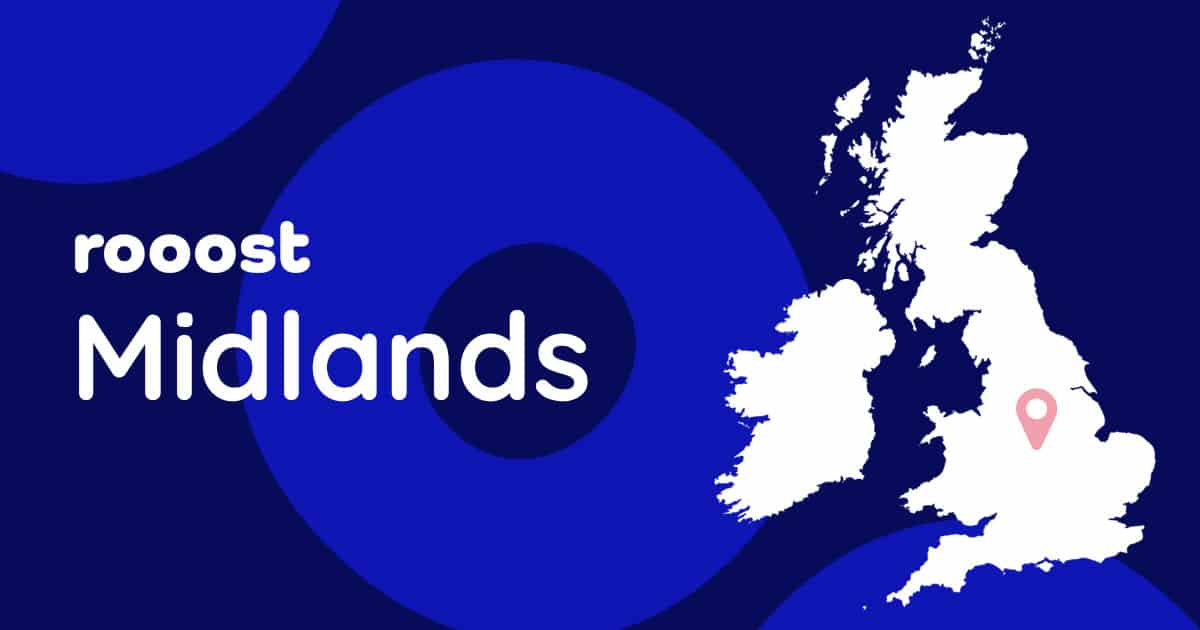Rooost in the Midlands

The Midlands – also referred to as Central England – is a part of England that broadly corresponds to the Kingdom of Mercia of the Early Middle Ages. It is bordered by Wales, Northern England, Southern England and the North Sea.
The Midlands region was important in the Industrial Revolution of the 18th and 19th centuries. It is now split into the West Midlands and East Midlands – and the region's biggest city is Birmingham (the second-largest city and metropolitan area in the United Kingdom) and often considered the social, cultural, financial and commercial centre of the Midlands.
Other major towns and cities of the Midlands, with a population of 100,000 or more include the following:
- Coventry
- Derby
- Leicester
- Lincoln
- Mansfield
- Northampton
- Nottingham
- Solihull
- Stoke-on-Trent
- Sutton Coldfield
- Telford
- Wolverhampton
- Worcester
The Midlands also includes the smaller cathedral cities of Hereford and Lichfield.
Whilst there is no single definition for the Midlands, it is generally considered to include the following counties:
- Derbyshire
- Herefordshire
- Leicestershire
- Lincolnshire (with the exception of North and North East Lincolnshire)
- Northamptonshire
- Nottinghamshire
- Rutland
- Shropshire
- Staffordshire
- Warwickshire
- Worcestershire
- West Midlands metropolitan boroughs
Additionally, there is an informal region known as the South Midlands which is considered to include the southern parts of the East Midlands and northern parts of Southern England.
Conversely, although the northern parts of Derbyshire and Nottinghamshire are officially part of the Midlands, they are often considered to be in Northern England, with northern Derbyshire (areas of which were historically in Cheshire) lying close to the cities of Sheffield and Manchester, and northern Nottinghamshire lying close to Sheffield. However, they are included in the North Midlands informal region which covers the northern parts of the West and East Midlands, along with some southern parts of Northern England.
The West Midlands region is geographically diverse, from the urban central areas of the West Midlands conurbation to the rural counties of Herefordshire, Shropshire and Worcestershire which border Wales. The region is landlocked, however, the longest river in the UK, the River Severn, traverses the region south-eastwards, flowing through the county towns of Shrewsbury and Worcester, and the Ironbridge Gorge, a UNESCO World Heritage Site. Staffordshire is home to the industrialised Potteries conurbation, including the city of Stoke-on-Trent, and the Staffordshire Moorlands area, which borders the southeastern Peak District National Park near Leek. The region also encompasses five Areas of Outstanding Natural Beauty, the Wye Valley, Shropshire Hills, Cannock Chase, Malvern Hills, and parts of the Cotswolds. Warwickshire is home to the towns of Stratford upon Avon, birthplace of writer William Shakespeare, Rugby, the birthplace of Rugby football and Nuneaton, birthplace to author George Eliot.
The East Midlands consists of Leicestershire, Derbyshire, Lincolnshire (except North and North East Lincolnshire), Northamptonshire, Nottinghamshire and Rutland. The region has an area of 15,627 km2 (6,034 sq mi), with a population approximately five million. The most populous in the region are Derby, Leicester, Lincoln, Mansfield, Northampton and Nottingham. The region has a diverse economy with a strong presence in the following:
- Manufacturing
- Construction and building materials
- Textiles and clothing
- Retail
- Food processing
- Healthcare
- High technology
- Finance
- Rural
- Entertainment
The Midlands region is at the heart of UK manufacturing and advanced engineering, accounting for more than 20% of UK manufacturing output through world leading business and industry like Alstom, Bombardier, Jaguar Land Rover, JCB, National Grid, Rolls-Royce, Tarmac and Toyota UK.

 share
share